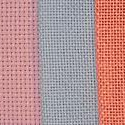
Aida, linen or evenweave? Differences and count
Choosing a cross stitch, Hardanger, or needlework fabric can be a challenging task with the plethora of choices. There are several different categories of cross stitch fabric: Aida, Linens, several types of Even Weave, Hardanger, Canvas, Perforated Paper, and specialty fabrics. Each different type of fabric in the categories has a unique texture, feel and sheen. Fabrics even smell different depending on what kind of material they are made out of and how they are dyed. Generally, people first learn to do counted cross stitch on Aida and learn to stitch on linen or other evenweaves as they become more experienced. But what's the difference?
Aida:
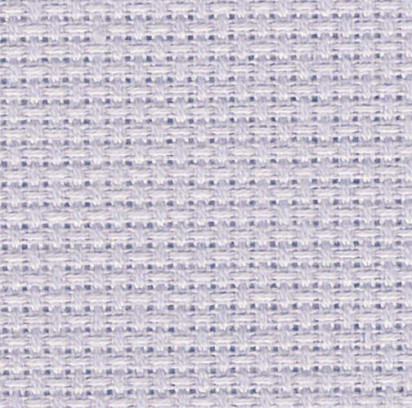 Aida fabric is certainly the single most popular cross stitch fabric. The name "Aida" refers to a particular weave of the fabric that was invented by Zweigart in 1908.
Aida fabric is certainly the single most popular cross stitch fabric. The name "Aida" refers to a particular weave of the fabric that was invented by Zweigart in 1908.
Aida is generally made from 100% cotton, and it comes in several different counts as large as Herta (6 count) and as fine as 20 count. Herta is often used for teaching children or beginners to cross stitch because it is easy to see. 18 and 20 count fabrics are for more experienced cross stitchers that are looking for a finer or more detailed look to their piece.
The fabric is made by little squares with four holes at the corners. The stitches are formed using these holes. It is available in many different counts, but the most common are 14, 16 and 18 count, that means respectively 14,16 and 18 stitches per inch - so, the higher is the count, the smaller will be your work.
Fractional stitches (1/4 stitches and 3/4 stitches ) can be much easier to do on an evenweave material. On Aida, the needle needs to punch through the middle of the little square in order to complete the stitch.
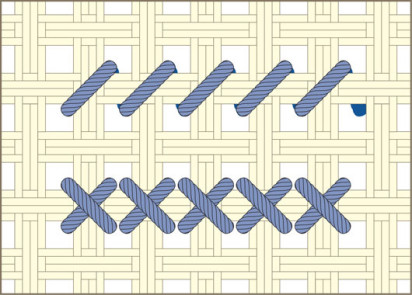 Aida Country French: is a cotton Aida even weave fabric that has a very soft, luxurious texture. It is great for baby quilts, clothing or washable items. It drapes nicely and comes in a variety of neutral colors. It does however fray quite easily, so it is best to surge or tape the edges when working with it.
Aida Country French: is a cotton Aida even weave fabric that has a very soft, luxurious texture. It is great for baby quilts, clothing or washable items. It drapes nicely and comes in a variety of neutral colors. It does however fray quite easily, so it is best to surge or tape the edges when working with it.
Aida Yorkshire: 14 count fabric is made of 96% cotton and 4% polyester. It is a rustic fabric and a unique alternative to regular Aida.
Evenweave:

The term evenweave applies to any fabric that is "evenly woven", so any fabric which has the same number of threads per inch in both the vertical and horizontal directions, and all the threads have the same thinckness.
The count are different from Aida, because in this case, we do not count the squares, but the threads. Normally evenweaves are worked "over two threads" (when you are following the chart you would miss one hole and go into the next) so basically you stitch on a square of 2x2 threads. In this case, you have to take the count of the fabric and divide it by 2 to have to correct size of your work.
For example if you want to have the same design size of 14 count Aida (14 squares per inch), you could work it on 28 count (28 threads per inch) fabric, over two threads (28/2=14). The cross stitches would be exactly the same size, and therefore the complete design would be the same size. This also has the advantage that part stitches are easier to do, as a hole already exists in the middle of each square.
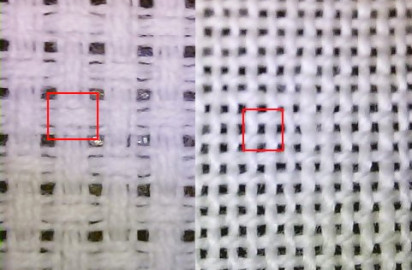

The most common count of evenweave are 28 count (= 14 count Aida if stitched over 2), 32 count (16 count Aids if stitched over two) and 36 count (18 count Aida if stitched over two)
Evenwave can also be stitched over one thread, and in that case you will have a proportion stitches/inch equal to the fabric count (i.e. 28 count = 28 stitches per inch)
Linen:
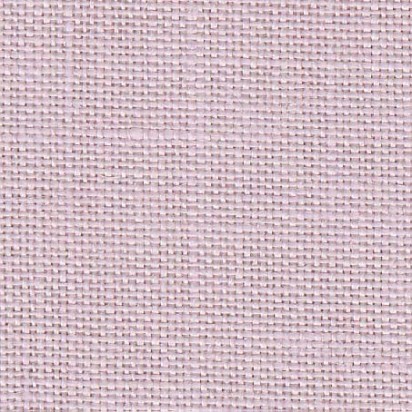 Linen is a natural fiber. The main difference between linen and evenweave is that linen threads have not all the same thickness, so basically the stitches per inch may not be equal vertically and horizontally.
Linen is a natural fiber. The main difference between linen and evenweave is that linen threads have not all the same thickness, so basically the stitches per inch may not be equal vertically and horizontally.
The stitching method and the count are the same as the ones you use for evenweave, and it can be stitched over one or over two exactly as evenweave.
Linen has a very "crisp" feel and offers a more “old fashioned” look to a piece. Traditional Linen has a very rustic look to it, especially in the more natural colors like "raw linen". Linen comes in several different counts including 18, 22, 26, 28, 30, 32, 35, and 40 count, that are usually identified by the name. The most common are:
Linen-Hardanger: (even weave) fabric is made of 100% linen and comes in 16 count. It is usually stitched over one thread and is a course fabric. The holes are prominent. It is a unique alternative to Aida fabric.
Cashel Linen: 28 count Linen also comes in a large array of colors and is stitched over two in most cases. It is 100% linen and less stiff than regular Linen fabric.
Belfast Linen: 32 count Linen comes in a large variety of colors and is normally stitched over two threads. Belfast is 100% linen and is softer than regular Linen.
Edinburgh Linen: 36 count Linen comes in a few neutral colors. It is made of 100% linen.
Newcastle Linen: 40 count Linen comes in a few neutral colors. It is made of 100% linen.
Other cross stitch fabrics:
Jobelan: is popular because of it's elegant, soft, smooth sheen and large variety of colors, including hand dyed fabrics. Jobelan comes in 20, 25, 28 and 32 count and is made of 51% Cotton, 49% Rayon/Modal. Jobelan drapes nicely and is a pleasure to work with. It is resistant to wrinkles.
Lugana: is a heavy fabric that is very versatile and similar to a Jobelan. Lugana comes in many colors and it is a blend of 52% cotton and 48% Viscose. Did you know that Lugana used to be called Brittney fabric? Lugana is a soft, heavy, even weave fabric that is easy to count and great for cross stitch. It comes in many colors and a few different counts like 25, 28 and 32 counts with the most color choices in 25 count. Lugana is an elegant fabric for table linens, samplers, pillows, and other decorative accessories. Lugana is also a great choice for Hardanger projects.
Tula: 10 count fabric is made of 60% rayon and 40% cotton, usually stitched over one. The holes in Tula fabric are prominent. It is a soft, unique fabric. It's comes in some lovely colors.
Waste Canvas: is used to stitch your design on fabrics that are not cross stitch friendly, like denim or T-shit cotton fabric, table cloths and napkins. Waste canvas comes in several different counts from 6.5 to 20 count. Waste canvas is usually marked with a grid in blue that breaks the canvas down into 10 count squares (just like a pattern) that makes it easy to count and to position your design in the center. Some people choose to use some fabric on the inside of the material they are stitching on to give added support to their stitches. This is called interfacing. Using a 6 stranded floss, you will generally stitch with two strands of floss. However, this is something that is left up to you to decide. If you are concerned that the floss colors will run, than you can soak each color of floss in water to remove any excess dye before stitching. To begin your design, be sure to center the waste canvas on your shirt, blue jeans, etc. You can baste or pin your waste canvas and interfacing to your project. Be sure to secure your floss firmly so it doesn't come undone when you wash your garment. Once you have stitched your design to your garment and you are finished, wet your waste canvas and gently pull it out from under your design so that all that is left is the design you have stitched on the garment. It is best to wash your garment turned inside out. Make sure the edges of your interfacing are trimmed close to the design so as not to be caught during the washing process and pulled off.








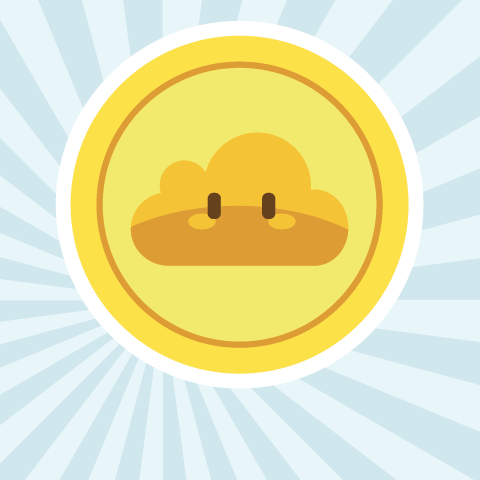



[…] Which fabric should I use? It usually depends from your stitching skills and, again, from personal taste. Most common fabric used fro cross stitch are Aida, Linen and EvenWeave. For a better explanation about this fabrics and how to stitch on them, you can see this post. […]
[…] If you need more info about the different fabrics and count, you can take a look HERE! […]
I have a picture to cross stitch on 25 ct. fabric. I would like to do on 14 ct aida. What size 14 ct would I need to buy?
Hello!
You can use out fabric calculator, you can find the link between the useful links on the bottom of this page!
I have worked on cross stitching on and off all my life. However, I have never worked on fabric and have never heard of the method of two over two. It is different not hard. I am working on a blanket for my first grandchild and I am confused on the pattern. The way the design is set up in the book it says to find the middle of the blanket by folding it and then the middle of the graph and count, just as with any cross stitching. Here is where I am confused, according to their counting i should count down 88 and then over to the left 20 to find the first stitch. By counting the blocks on the pattern it is half of that.of 44 down and 10 to the left. By going by the pattern I would assume when I count the blocks i count each block as 2 not one right? I would also assume when I count on the material from the center would I count two blocks as one or as two? By research I figured out that when you are cross stitching you will have three openings, one in the middle on the sides. So, what I am trying to ask is when counting the material would you count that one stitch as one or two? I hope I am being clear here.
By logic it seems like each block on my pattern is counted as two and not one and with the material two blocks are counted as one and stitched as one? Right?
Thanks for any help :)
Hello Pamela! Your material id probably linen or evenweave? In this case you have to count 88 threads, that is like 44 aida squares if working over two threads. Same for the other count. Hope this helps!
[…] it. If you need any help starting out then have a look at this link…it set me right. Click Here to read more. The Simple diagram that shows you what to look for when stitching on Evenweave was […]
[…] comohacerpara, cloudsfactory, merceriasires, […]
I would like to a make a picture on 14 count aida cloth instead of the 28 count linen fabric
which the pattern calls for. Would the picture be the same size as the 14 count if I used the
aida cloth? I sure would like your information on the fabric. My eye sight isn't as good as
it used to be. Thank you
Yolanda Dimarzio
Yes 28 linen stitched over two or 14 count aida are the same size (28/2 threads = 14)!
If you're in trouble with sizes you can also use our fabric calculator here: http://cloudsfactory.net/fabric-calculator/
[…] (I’ve only worked on Aida, 14 count). If you have no idea what I’m talking about, this might be a good site to check out, but I’ve found it’s possible to get Aida in most places that also sell embroidery […]
I'm looking for 14 count Evenweave fabric but I can only fine 28 count can you please help
Evenweave count is not like aida. The count is the number of threads that there are in 1 inch. If you stitch over 2, to have the same result as 14 count aida, you have to look for 28 count evenweave. It is all explained in the post.
I am trying to figure out how many holes stitched on Edinburg linen fabric equal I cross stitch? This is my first time using this fabric for cross stitching a pattern design area 8 3/4 x 7 1/3. Thank you.
Hello! As explained in the post, Edinburg is 36 count linen. So if stitched over 2 threads it's the same of a 18 count Aida. If you look above there is an image that explains how to stitch over 2 on evenweave and linen.
On Miribilia Bluebeard's Princess Mermaid its on 32 Laurel Cashel Linen 18" X 27". I woiuld like to convert it to either 28" or 16 " AIDS, so that it's easier to see. Could you tell me the size of fabric I would need? Also if I could get it in a color closer to Laurel (similar to moss green). Thank you
To calculate the size needed you can use our fabric calculator here: https://cloudsfactory.net/fabric-calculator/
About the fabric color, I think you better ask the designer as we're a different Company ^_^
[…] For your first projects fractional stitches are perhaps best avoided, as they are more suited to the higher count evenweave fabrics. […]
Re: Game of Thrones- Houses Banners crosstitch design/pattern: please clarify is the thread color 169 (DMC) use to outline the Siegel design for the 'House S ' is the same color as the background. Your speedy response is appreciated. Thank you.
Hello Ruth, we have an Help section on the top menu of our shop for issues and questions :)
DMC 169 is used for the bottom fringes and 413 for the Wolf backstitch. On the backstitch legend scheme that you can find right after the pattern in your PDF, the colors are listed in usage order, from the top to the bottom of the banner :)
Hope this helps!
Cross stitch. Baby in a Basket calls for linen. I want to do it on Aida. Directions say no! why? Designer is Leavitt-imblum
If the pattern calls for linen, there may be many half stitches or other special stitches that don’t fit good on aida, so you probably better ask to the designer of the pattern as we're a different Company ^_^
Hello. I've got a pattern for cross stitch on 28 count evenweave, can I use 18 count aida for the same pattern or do I have to get 14 count for this. Thank you. Janet.
Hello Janet. 28 count evenweave = 14 count aida. If you work on 18 count, your final project will be smaller. If the pattern calls far evenweave anyway, there may be many half stitches or other special stitches that don't fit good on aida, so you probably better ask to the designer of the pattern.
I have always used Aida Cloth in my cross stitch projects. A project I have instructions for calls for Cashel Linen.
It it easy to to cross stitch on? The piece is a Christmas gift for a teenage Grandson.
Thank you for any advice or information you can give me.
Thank you!
Rachael Keith
Hello Rachel. On linen you usually work over 2 threads instead of over one square like you do on Aida. On this tutorial you can find some examples that may help you!
I have a pattern that calls for 32 count fabric can I use 14 count Aida
32 count linen = 16 count Aida. If you use 14 count, the final result will be slightly bigger. If you need to calculate the new size, you can use our fabric calcualator here: https://cloudsfactory.net/fabric-calculator/